Ellen and Jim Have a Blog, Too
We are two part-time academics. Ellen teaches in the English department and Jim in the IT program at George Mason University.


_The Pallisers_, 6:11: Sex, babies and pressure · 19 May 08
Dear Readers,
Here is a third blog on Volume 6, Part 11 of Simon Raven’s 1974 Palliser films (BBC, directed by Hugh David, produced by Martin Lisemore). We’ve looked at the introductions of Lord Fawn (Derek Jacobi) in 5:10, and Fawn and Lizzie Eustace in 6:11. Now I provide some opening thematic interpretation, concise descriptions of the episodes & scenes, & brief transcripts of key dialogues in 6:11.
The episodes of Volume 6, Part 11, swirl around sex, babies and pressure. We are given juxtaposed scenes where the characters are alternatively pressured into having or refusing sex & marriage. The problem (as in real life) is sex leads to babies, and for women babies born outside marriage are shaming, and for everyone babies born inside marriage inherit property.
The episodes are made up of contrasting sex relationships: Violet Effingham (Mel Martin) succumbs to having sex with Lord Chiltern (John Hallam), and they marry; Lady Laura refuses to have sex with her husband, and they break up; Phineas Finn (Donal McCann) carries on having sex with Mary Flood (Maire Ni Ghrainne), pressured by her, they become engaged; she then finds she is pregnant, and writes a letter to him, again pressuring him, and he agrees to return to Ireland to marry her. The Duke of Omnium (Roland Culver) carries on pressuring Madame Max (Barbara Murray) to become his mistress and when she refuses, his wife; Lady Glen (Susan Hampshire) lives in fear that the Duke will succeed, and Madame Max become pregnant; Madame Max and her baby will then take the title Lady Glen has given up much for and wants for her son, so she (successfully) pressures Madame Max to say no; the payment is an understanding that Lady Glen will become Madame Max’s friend and advocate publicly and privately.
We have one parallel political scene and some choral political commentators, Barrington Erle (Moray Watson), Lord Brentford (Lockwood West), Dolly Longestaffe (Donald Pickering) who though confines himself to sneering at Phineas and casually misdirecting Kennedy: Phineas has three visitors: Kennedy comes to pressure Finn to stay away from Lady Laura because Kennedy now has lost perspective and believes Phineas may be her lover, and Lady Laura comes to ask Phineas to help her escape Kennedy; but first Plantagent (Philip Latham) also comes to pressure Phineas into not voting with Monk (Bryan Pringle) for Irish tenant rights because if he does he will lose his place in the government and salary. We have a glimpse of Quintus Slide (Clifford Rose) writing castigating columns about Phineas, and stray comments about what Phineas is going to lose. The part climaxes equally on Phineas’s rejecting Madame Max’s second offer of money, this time with herself, Lady Laura’s escape, and the aging Duke’s physical collapse.
To the episodes:
Volume 6, Part 11, Episode 11: “Violet Accepts.” Scene 1) Loughlinter, Christmas time, Lady Laura in black goes to light fire, and Kennedy attempts to stop her from building it too large; she objects that her brother, Lord Chiltern, and Violet Effingham are their guests and it’s cold; their bitter conversation is made up of his resentment of Chiltern and Violet’s presence because he feels they have been brought together to come together sexually (Kennedy’s hatred comes from his libinal frustration). . The conversation comes from Phineas Finn, Chs 51, p. 492 (1972 Penguin ed JSutherland), much transformed to fit new context, that of Christmas, one Trollope likes to use for parallels in his novels (e.g., Orley Farm); as Laura remarks, for her and Kennedy Christmas is not a time of “rejoicing.” Chiltern enters and enjoys flouting Kennedy’s assumption he will go to church: Violet has a bad cold, and “it’s the sort of thing I never do.” Kennedy sullen and startled upon being flouted:
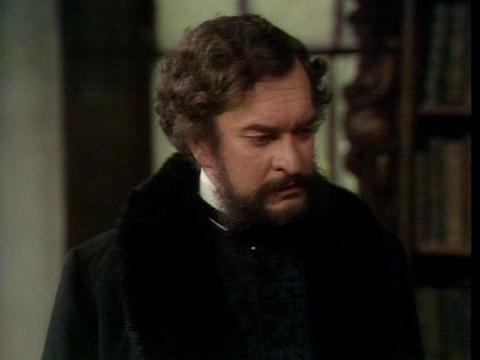
Kennedy (Derek Godfrey) flouted by Chiltern leaves the room abruptly. Lady Laura with a look of peculiar flat bitterness more lingeringly.
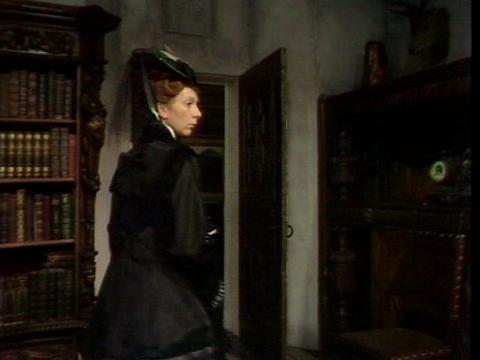
Lady Laura (Anna Massey) looking at her brother
Chiltern was always a bone of contention between the couple; from the beginning, Kennedy would not allow Laura to speak in praise of her brother. Now Chiltern has it all, and soon Violet will be in the room and Chiltern will impose his will on her and (in the film segment) clearly have sex with her as part of taking her as his wife. And it was Chiltern Laura sold herself to Kennedy for. He is not looking at her and seems careless of her.
It’s the look in Anna Massey’s eye as she looks at him that tells this complicated tale of a sister’s self-deluded martyrdom. Chiltern can take sexual satisfaction where he wants; she cannot. She can do nothing but follow this bitter man to church.
Chiltern takes the stage alone for a few seconds, lighting himself a cigar (from his own store as Kennedy’s box is empty), and then Violet and the two wish one another a Merry Christmas, but then Chiltern gets down to pressuring Violet to be his wife, through imposing himself on her as her sex partner. She had said she liked smoke, and he takes this as a cue to pressure her into accepting his violence which in their conversation he equates with truthful love-making; he makes explicit a macho male argument that the woman who accepts this sort of treatment is “worth [a man’s] care.” Chiltern tells Violet she is a hypocrite and doesn’t want to admit men are animals and she’s an animal too, and grabs at her; at first she is taken aback and tries to escape him:
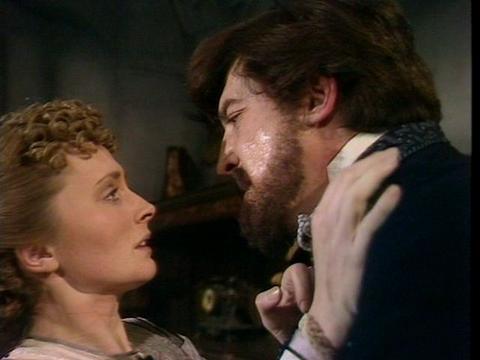
Violet (Mel Martin) sweats under the impact of direct aggression by Chiltern (John Hallam), but then (like Raven’s Alice Vavasour made to pant over John Grey’s description of himself fighting George), yields passionately.
Although we are not told sex happen as explicitly as in the Phineas-Mary scenes, the dialogue leads up to it, and the focus of the camera on the fire for a few seconds after the two collapse into one another’s arms is clear enough. The whole scene is in contrast to Trollope’s depiction of them coming together (Ch 52, pp. 493-97a) where Chiltern asks in a courteous chivalrous way, and goes on his knees, and is on his way to becoming ethical since Violet has accepted him because he has been (unlike Finn) constant to her (in Trollope’s thematic terms in the novel, not for sale, which Phineas turns out not to be either, but only after he has been refused by Laura and Violet.)
Scene 2) Ireland, Phineas’s father’s house, also Christmas time, and Phineas (Mary standing to his side) proposing a toast to Monk; dancing ensues, and Phineas first pulls Mary aside to kiss her in the hall (we get an exchange of Merry Christmas which parallels Chiltern and Violet’s), and then proposes she meet him in the night nursery instead of dancing there with her, all the while careful not to let Monk see how he’s treating this girl.
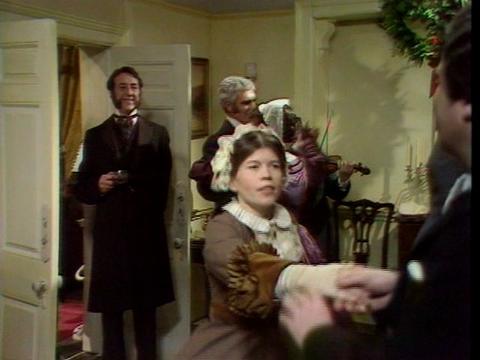
Mary (Maire Ni Ghrainne) pulled back by Phineas (Donal McCann) llest Monk (Byran Pringle) see what he’s doing to this young woman
Scene 3) Loughlinter, another day, still Xmas, and Violet is telling Laura she has “accepted” Chiltern (the word is used to suggest sex as well as marriage); Laura rejoices and Violet goes off to write to her uncle (it seems Osward was not sufficiently in love to stay more than the time it took him to get a yes from Violet) and, with pity in her eyes, suggests Violet should be the one to write Phineas. (This is from PF, Ch 51, p 491). A letter writing segment ensues (not voice-over but reading aloud), where Laura is interrupted by Kennedy and a powerful clash emerges where Laura tells Kennedy that Finn is “loved by me very dearly,” and he comes near to violence, grabbing her quill, tearing her paper, and (apparently) stopped from hitting her by her threat to make his behavior public.
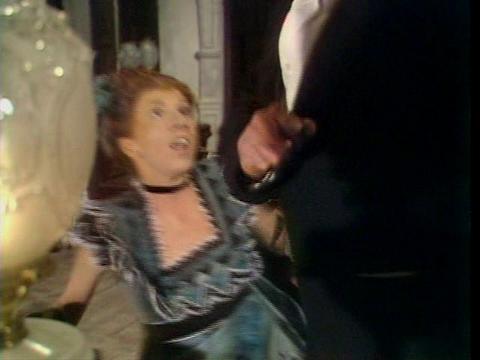
Lady Laura falls back under the impace of Kennedy’s threatened violence
But her threat ultimately bests him, and when he walks out, she returns to her letter. Raven takes material from a letter from Laura to Phineas (PF, Ch 64, pp. 611-12), explaining what has been happening between her and Kennedy and uses it for this and other dramatic scenes in this part.
Episode 12: “Secret Engagement.” Scene 4) A bedroom in Phineas’ house, a few days after Christmas, Mary and he both fully clothed, but probably about to renew their first tryst. Mary demands that Phineas speak; he says, “Oh, I love you, Mary, I love you, very dearly,” but she cuts him off with that’s not enough, and demands a promise of marriage; he tells her of the precariousness of his position, and that he cannot marry, but reluctantly agrees to an engagement on the understanding Mary will keep it secret. Mary cries hard during this scene more than once, & the scene concludes with a grave look on his face as he considers her. Scene 5) Loughlinter again, now winter, Lady Laura playing chinese checkers and Kennedy sitting gloomily before the fire. Another quarrel this time as Laura demands to know when they are going to London, and he retorts that he does not know that he will permit her too; she says he cannot keep her prisoner, she can go to her father, to which he replies “You’ll be penniless;” she tries to argue that her conduct to him has been the result of his not using “kindness and confidence” in his behavior to her ever, pleads with him (trying to touch him with her arms, but he will not bend or flex, and begins to show signs of insanity (“I must think. I must pray …”); humiliated she stands up and returns to her Chinese checkers.
Raven has juxtaposed Phineas’s compromise with Mary with Kennedy’s refusal to compromise. It’s not that Phineas is an ideal man. In 5:10 (“A double life”), Finn is shown having had sex Mary immediately after he was begging Violet to marry him; and in this scene how he’s half-lying to her when he says he hasn’t enough income (she counters that with her knowledge that a secretary has a good income).
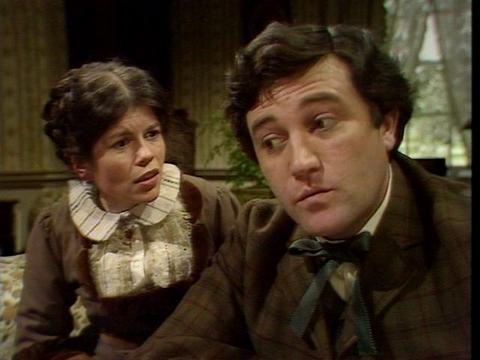
Mary (Maire Ni Ghrainne) puzzled, upset by Phineas’ posing
These scenes contrast with his high-minded stance on Irish Tenants Rights. Raven wants to bring down Finn, and he also is using Mary’s pregnancy and Phineas’s half-willingness to marry her and return to Ireland (his growing disillusion, unstated but felt) to become part of the motivation for why Phineas does finally vote for Irish tenant rights after Plantagenet and others have told him repeatedly if he does that and they go out of office he’ll not have a place with them (and thus no income). The chapters in PF where Phineas binds hiimself to Mary show him getting openly engaged to her in Ireland and treating her with courtesy and confiding in her his political ideals. By contrast, Laura torments Kennedy & he tyrannizes over her. Both scenes show waiting games, performative behavior, rebarbative insincerities and create a perspective which does not allow us to romanticize Chiltern and Violet.
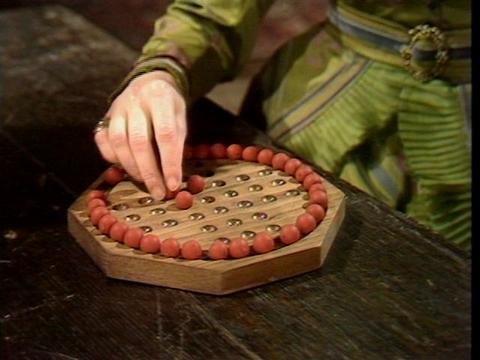
Lady Laura begins and ends the scene with Kennedy playing Chinese checkers
Phineas and Mary are a non-romantic norm for lovers; Plantagenet and Lady Glen a non-romantic compromising norm for married couples. Phineas is not sincere with Mary but she is giving herself to him and sex is fulfilling and he promises; by contrast, juxtaposition we see Lady Laura at her chinese checkers, the arrogance of Kennedy; the marriage is through this juxtaposition over. Contrasting scenes: Chiltern demands rather than appeals; Mary and Laura appeal; Violet gives in, Phineas minimally obeys his conscience; Kennedy does not, but then Lady Laura has given nothing (sex) of what he wanted. The scene of Episode 12 between Laura and Kennedy resonates across series: it harks back to Violet telling Phineas in 4:8 of how cruel he is (he won’t let Laura speak in praise of her brother), and forward to to Emily Wharton (whose sexuality as a woman is played up far more than any other in the series).
Scene 5) Phineas Office: he is reading a letter and we hear a voice over of Mary, going on about her love for him; Plantagenet Palliser comes in; Palliser says he is “just passing,” but he has in fact come to tell Phineas how pleased Gresham and he are with Phineas’s work on the colonies (but grows bored when Phineas tries to discuss his map), and then to urge Phineas not to join Monk openly; Scene 6) Quintus Slide’s office, voice over of Slide saying with the end of rotten boroughs we can look forward to the banishment of …. dissolve into the next scene and Madame Max’s voice saying “Ah, Mr Finn”
Episode 13: “Duke’s Request.” Scene 6) Madame Max’s London apartment. Madame Max teases Finn archly with Lady Glencora’s intuition Phineas has a “new mysrtery about” him and what can it be but romance. Phineas looks like he is about to tell the truth, but denies any romance and says “You must have heard that Violet Effingham whom I loved has married Lord Chiltern,” whereupon as she did in 5:10 Madame Max says there are women enough “to understand and to realizse that what rally counts is the man” (not the title); nonetheless, when his Grace the Duke of Omnium is announced, Phineas must depart, and the two banter congenially as two conspirators (or outsiders) who are taking all these performances with a grain of salt. We are perhaps to see these are our real temperamentally suited couple (the first we’ve had since 1:1, Burgo Fitzgerald [Barry Justice] with Lady Glencora):
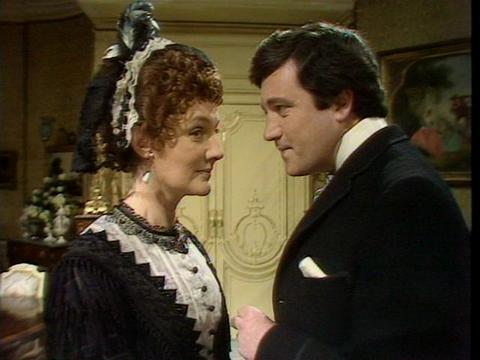
Madame Max (Barbara Murray) and Phineas archly teasing one another about their behavior to the powerful they are surrounded by
But this kind of romantic thought is undercut by Phineas’s way of referring to his “secret” as “too slight a thing to bother” with when the Duke of Omnium is coming. This viewer at least thought of how such a statement would have pained Mary—whom we are not allowed to forget (we have two more letter scenes in the part). The matter for Phineas and Madame Max’s conversation is a transformation of liines from PF, Ch 54, pp 518-19; the matter between the Duke and Marie (as he now calls her) comes from Ch 60, pp. 569-71. The Duke is now photographed in a way to make him look small and old, and evinces but a mild playful jealousy (“Mr Finn, again, Marie?”), but then proceeds once again to pressure Marie to become his mistress. Madame Max has a hard role here, for she must not offend the Duke as he has been her main patron; she evinces intense relief when Lady Glencora (together with little Planty Pall) is suddenly announced and the scene turns into the old man playing with his presumptive heir and referring to his coming demise (to say his nephew is not eager for the title) as the two women look on.
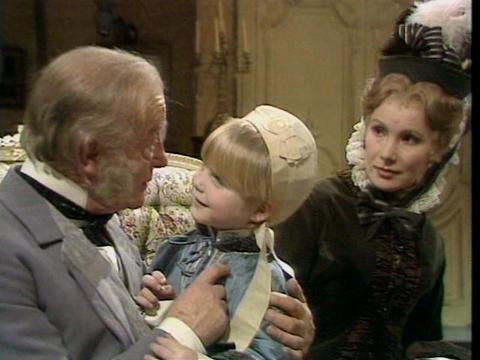
The duke (Roland Culver) plays with little Planty as Lady Glen (Susan Hampshire) looks on
Scene 9) Phineas’ office: this time the visitor is Lady Laura who glides in with a grim expression, asking Phineas to be ready when she needs him. This scene contains a striking interchange wholly original with Raven:
Laura: “I shan’t be able to come here again and you mustn’t come to Grosvenor Place.”
Finn: “Why not?”
Laura: “it would be cold, stiff, horrible.”
Scene 10) Madame Max’s apartment. Here the Duke again pressures Madame Max to become his mistress, but seeing she will not, startles her by proposing marriage. The way in which Madame Max treats it as a sacred honor is curiously more teleological and naive than anything in the letter Trollope has her write and send the Duke (Ch 62, pp. 587-88) as her refusal. Trollope has her talk of how she would lose reputation and so would the Duke (as she does in the later scene, see below), as well as how he would tire of her (not in Raven’s film), but beyond that what she says to show she is conventional is “I do not despise the rich things of the world, or the high things,” and evinces no religious awe. It was risky of the film-makers to dwell on this romance as Culver is an aging man and Barbara Murray not young either; it is true to Trollope who does occasionally present older lovers (e.g., Lady Carbury and her editor in The Way We Live Now).
Episode 14: “Glencora’s Worries.” Scene 11) A corridor outside Phineas’s office and then the office itself. Kennedy now stalks in grim as Laura, and a conversation ensues where Phineas at first tries to treat Kennedy as his friend and colleague, but it breaks down as Kennedy persists aggressively, keeps pressuring and meddling and insisting they discuss Phineas’s relationship with Laura; the scene concludes with Kennedy accusing Phineas of dishonoring him (having an affair with Laura) and Phineas pushes Kennedy out the door. Scene 12) The Palliser drawing room, London, again a much gilded fireplace (identified as 24 Park Lane early in the series). Plantagenet attempts to persuade Lady Glen not to intervene to prevent the Duke from following his wishes about Madame Max as 1) the Duke is too old to father children, and 2) he may not marry Madame Max, and 3) it will do no good. Lady Glen’s reply is fiercely to want to protect her interest, insist “this woman has stirred him” and she is young enough to have a baby. The scene is a strikingly vivid development from a conversation between Palliser and Lady Glen in PF, Ch 57, pp. 545-48.
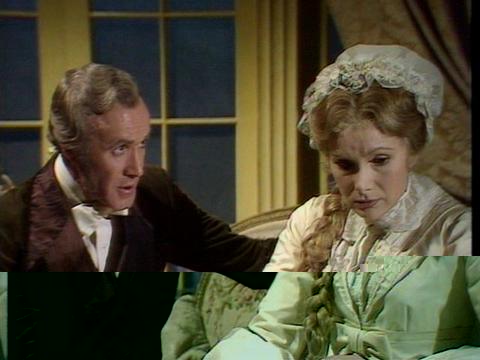
Plantagenet (Philip Latham) tells Lady Glen there is nothing they can do to control the Duke (i.e., prevent his marrying)
Scenes 13 & 14) Mary Flood Jones’s room. A letter writing scene which begins with a woman’s hand writing a letter, proceeds by voice-over, and ends on Phineas’ face in his office as he reads (listens): Phineas has not written, and although Mary told herself she wold not “pester” him, she can now “wait no longer” for she is “with child”. The parallel juxtaposition of Lady Glen’s fear Madame Max will have a child and Mary’s real pregnancy and Phineas’s striken face is effective. Mary has gradually been made to look much older than when we originally saw her.
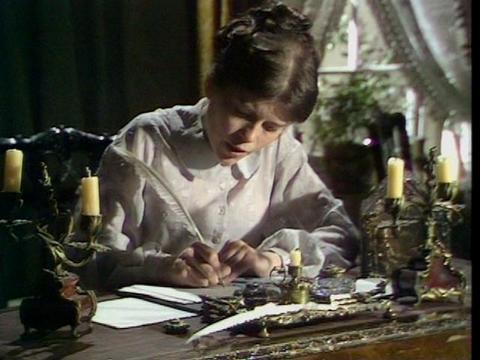
Mary (Maire Ni Ghrainne, suddenly made up to look older) writing to Phineas
Scene 15) Madame Max’s apartment. The climactic dialogue of Madame Max and Lady Glen (which binds the stories of Lady Glen and Plantagenet from 1:1 on to Phineas’s here) where Lady Glen attempts to persuade Madame Max not to marry the Duke. It occurs in womens’ novels repeatedly; the most famous parallel is the clash of Lady Catherine de Bourgh come to argue Elizabeth Bennet out of marrying Fitzwilliam Darcy. While abbreviating and making more concise, Raven sticks close to the line of argument and striking statements of Trollope’s Chapter, 61, pp. 580-82, “The Duel.” A curious stage prop is next to Lady Glen is a statue of a madonna with a baby.
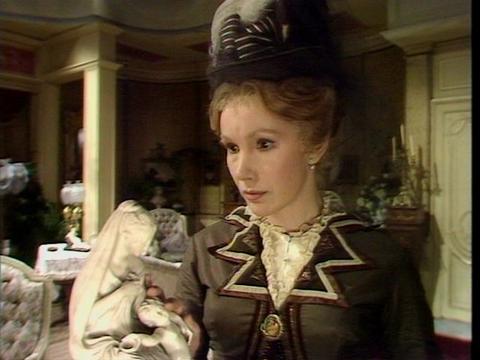
Lady Glen next to a Madonna statue in Madame Max’s room
Here is the key exchange:
Cora: “What would you gain by this marriage? You have money and social position.
Marie: “Social position, yes. But not one such as yours.”
Cora. “But you are free, yes free, you go where youwish, you do as you please.”
Marie. “Too free. Sometimes.”
Corea. “And what would you gain by changing all this simplyfor a title.”
Marie. “To be called cousin to the Queen.”
Cora. “And for that you would rob him of all his friends, degrade him among his peers.”
Marie (now angered, whispers fiercely): “Degrade him? Who dares say that I would degrade him. He will exalt me but I will no whit degrade him.”
Cora: “Anyone anyone Madame Goesler. It is not I that despise you. Well if I did would I offer you my hand in friendship … ”
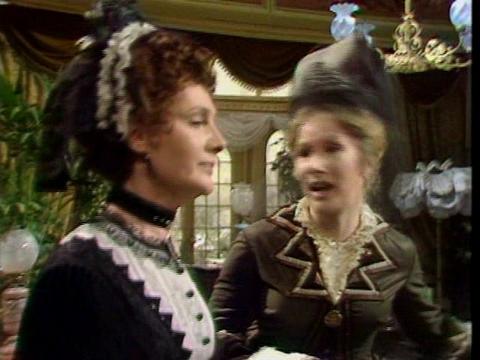
Madame Max upon being told by Lady Glen (somewhat frantically) she will degrade the Duke if he marries her
Scenes 16 & 17) Phineas office. Again we are with Phineas, the same evening or another, now writing to Mary that he will keep his promise and come and marry her. It begins with McCann reading aloud and switches to voice-over as the camera dissolves and moves to Mary in Ireland, her room, in different clothes now (and looking heavier and yet older) clutching the letter. Scene 18) Marie’s apartment. The duke comes in to hear Madame Max’s answer to his proposal of marriage (two days have gone by since Episode 13, Scene 10). As with the scene with Lady Glencora, Raven follows the line of Trollope’s imagined argument for Madame Max (Ch 62, p 587). He accompanies his proposal with a case containing fabulous looking diamonds; in this visual way Raven anticipates the diamonds of Lizzie’s story; we can contrast Madame Max’s response. She hardly looks at the necklace; simply, gently closes the box as irrelevant. Scene 19) Lady Glen’s private room in her London house, she and Marie now sit together drinking tea. Marie tells of her decision, Lady Glen tells of how she gave up the man she loved to marry Palliser and produce this heir; Marie tells her there can be others, but Lady Glen says now she will come to Marie for advice, and begins to hint how she will help Marie to gain Phineas Finn as her lover/husband. They have become friends.
To sum up this episode in the context of the series: Unlike Trollope’s book a direct parallel is set up between Phineas’s acquiescence to Mary and Madame Max’s gradual decision to refuse the Duke’s offer. There is no parallel scene of Mary’s pregnancy and letters; the scene dramatized by Raven is taken from Chapter 62, pp. 583-90 (free indirect speech of Trollope as Marie and then Marie’s letter to the Duke).
The scenes of Pallisers together keep up a long-strung out plot of their original relationship; now they worry about duke marrying; others showed us the young heir growing up like a punctuation of a kind of roman fleuve film. Lady Glen & Madame Max’s scene is a duel so parallel to Kennedy v Phineas and Phineas v Chiltern; here the parallel is also Phineas & Mary: Lady Glen fears Madame Max’s child; Mary’s child beats Madame Max out too and brings Phineas to her. The Madonna statue unites these characters. Lady Glen’s insistence on Madame Max’s freedom important in this episode: Lady Laura has none; Mary had none; Lady Glen has it in limited way. Violet gave up hers. That Lady Glen and Madame Max scene sandwiched around Phineas’s letter (an alternation of Lady Glen/Planty then Phineas/Mary then Lady Glen/Madame Max then Phineas/Mary).
The movement from Phineas & Mary to Duke and Marie again: by juxtaposition, they are true lovers being forced apart by world’s circumstances and norms: he must marry or be a cad; she must not marry or be despised. Two outsiders pushed in directions away from one another. In novel the letter the scene is dramatized from has Marie talking of herself as someone he would have to blush for given her position but she has done nothing wrong; no parallel in novel, but in film the parallel is Mary would be besmirched if anyone knew, Mary would be degraded and by marrying her Phineas hurts or at least does not help his position.
Final code of confrontation at end of 5:10 is Madame Max drinking tea; it’s understood Lady Glen will be her friend; in film Madame Max decides friendship of Lady Glen preferable to marriage to Duke; in book the friendship cannot be presented as cemented so quickly this way; it must emerge over time as they are not equals in rank nor position (Madame Max’s position in book is far more ambiguous).
Episode 15: “The Escape.” Scene 20) Another garden party at the Duke’s great house, presumably Gatherum Castle. Trollope’s Chapter 64 where Phineas bids adieu to each associate and friend as he goes up the stairs, is transformed to be another of these coda-transition Arcadias in the series. As in 1:1 and 3:6, we see people playing croquet, an oneiric lake; this time a castle is seen from on high. First we see a gloomy Lord Brentford taking a bottle of champagne. We switch to the Duke who no longer sits alone in command, but is sandwiched between and presumably influenced by on one side Lady Glen and on the other Madame Max. The camera emphasizes Lady Glen in the left hand corner; she is now in charge. Lady Laura veiled and Kennedy’s encounter with Lady Glen; as they go off, Lady Glen remarks there is something wrong here.
Lady then urges Marie to go to Phineas who is seen alone on the lawn in the distance. Marie tells the Duke she will be gone but a few moments, and comes upon Phineas below. A poignant and congenially teasing dialogue ensues, as a kind of thrown-away climax since it’s so short and seems to come anticlimactically. Raven transforms Madame Max’s offer of herself for his mistress and money (Chapter 72, pp. 683-84) into Madame Max’s gentle hint of an offer of herself and money, saying she wants to be of use to someone, to him, and Phineas appears not to hear the hint, hurrying off with the hope she will find someone.
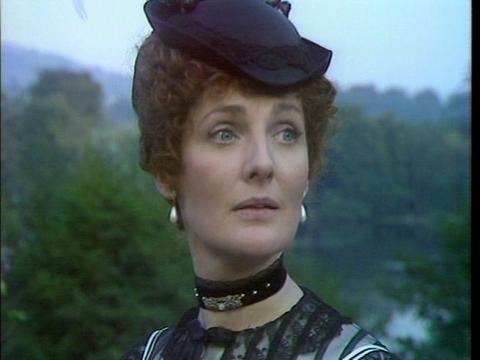
Madame Max (or Marie as one feels like calling her increasingly) rejected by Phineas
This scene is followed by Palliser talking to Barrington Erle, where they regret that Phineas will indeed vote for Irish tenant right and thus lose office. Palliser is sympathetic: “Mr Finn looks depressed … it is a pity.” He cannot know about Phineas’s coming marriage—the engagement is a secret in the film (in the novel it is not but apparently upper class English people do not hear what is going on with middling Irish Catholics in Ireland). Now we get the first two scenes of Lizzie Eustace and Lord Fawn: Lady Glen (eating an apple noisily) asks where that little Lizzie Eustace is, and the Duke gives the abbreviated history, we cut to them in Scene 21) the carriage, late, and then
Scene 22) Back to the gardens where in a picturesque still we see Lady Laura’s signal to Phineas to come into the greenery to plan the escape—as does Dolly Longestaffe who misdirects Kennedy who is now alertly hunting for Laura and walks alongside the greenery more than once. The scene of frantic conversation and plan within the greenery by Phineas and Lady Laura repeats in colors and feel the scenes of 1:1 where we saw Burgo Fitzgerald (Barry Justice) and a young Lady Glen hiding from others. We then have Phineas’s unpleasant encounters first with the sardonic (but observant) Dolly Longstaffe and then with Kennedy (silent) himself, and finally Lord Brentford who has just heard of Phineas’ duel with Chiltern.
A long chapter in Trollope’s novel has the lord reject Phineas as a traitor to his family but this is irrevelant or wrong here, as the point of contrast is that when we first saw Phineas in the gardens (3:6), he was an outsider, snubbed, kept out of all the secrets, now like Madame Max he seems welcomed, seems one of them, but is not quite. In his case he must continue to earn his place by helping Lady Laura and he must vote his real convictions (not to live a double life) and return to the young woman he has impregnated.
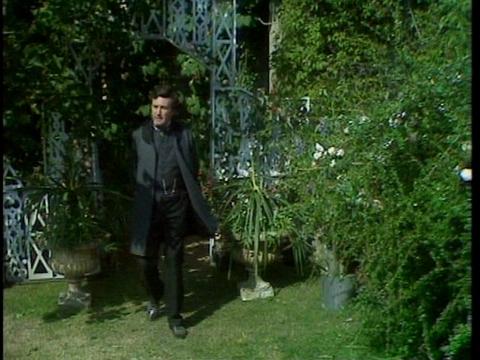
Phineas tracked by camera
Now the acrobats come, and the Duke, Madame Max (sad look on her face) and Lady Glen are tracked as they walk down the flight of stairs to take their places before the crowd and give the signal for the circus act to begin; they are still talking of and are intercepted by Lizzie and Fawn. Gently the two women maneuver the Duke away, Lady Glen leaving him to Marie’s care while she goes to talk to Palliser.
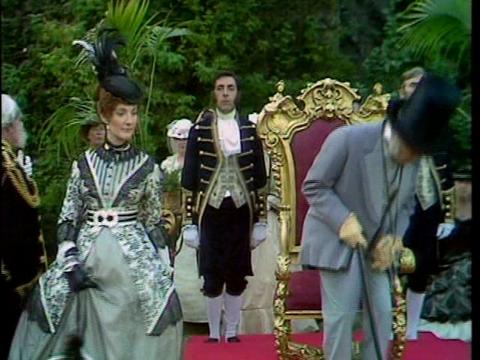
The Duke and Madame Max take their places
And now the finale: we return to one of our choral pairs, Barrington Erle and Dolly Longestaffe who have next to them an obsessed Kennedy who is not watching the acrobats; through an arch their shoulders make we watch glimpses of Laura darting behind the crowd seen climbing the stairs to the back of a wall, when Kennedy sees her, rushes afterwards and up the stairs, only to find Phineas waiting there, ready to interpose his body sufficiently long to allow Laura to flee with her father, who is waiting in a carriage.
These scenes are switched back and forth with scenes of the Duke sitting next to Madame Max, the acrobats beginning; a quick cut to the Palliser who look up to see Phineas and Kennedy struggling on high, and then back to the Duke his taking champagne (recalling 1:1 when he started the waltz and took champagne), only this time he begins to choke; and Marie frightened for him runs for help. The penultimate line of the part is Lord Brentford’s “So distressing sneaking away like a pair of cutpurses” while Laura shuts the carriage door as the carriage begins to move:
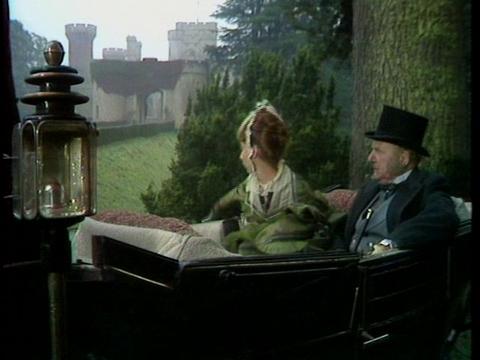
Lady Laura enters her father, Lord Brentford (Lockwood West)’s carriage
The last line is Madame Max as she runs through the crowd:
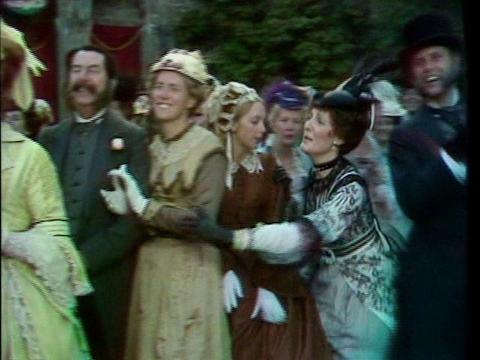
Madame Max trying to reach the Pallisers for help
reaching the Pallisers to say: “Excuse me, please … please come at once. His grace, the poor dear Duke” while the crowd continues to laugh at their trivial physical amusement, bringing to my mind Auden’s famous poem, “Musee des Beaux Arts”
About suffering they were never wrong,
The Old Masters; how well, they understood
Its human position; how it takes place
While someone else is eating or opening a window or just walking dully along;
How, when the aged are reverently, passionately waiting
For the miraculous birth, there always must be
Children who did not specially want it to happen, skating
On a pond at the edge of the wood:
They never forgot
That even the dreadful martyrdom must run its course
Anyhow in a corner, some untidy spot
Where the dogs go on with their doggy life and the torturer’s horse
Scratches its innocent behind on a tree.
In Breughel’s Icarus, for instance: how everything turns away
Quite leisurely from the disaster; the ploughman may
Have heard the splash, the forsaken cry,
But for him it was not an important failure; the sun shone
As it had to on the white legs disappearing into the green
Water; and the expensive delicate ship that must have seen
Something amazing, a boy falling out of the sky,
had somewhere to get to and sailed calmly on.
I also suggest the stills put together show women at a decided disadvantage to the men. They are enveigled into marrying and having babies, at the same time as they are at continual risk of violence, bullying, lying and non-performance of promises, & powerlessness (Lady Glen had she not persuaded Marie that Marie was better off being her friend than the Duke’s wife-mistress), or the kind of life-in-death Lady Laura flees into nothingness from.
The Pallisers is great televisual art, using the technology and capacity of TV (including the smallness of the screen) to convey serious adult themes.
Ellen
See various links and a concise summary of 1:1-3:6, 4:7, 4:8, 5:9, and 5:10.
--
Posted by: Ellen
* * *
Comment
- On the still of Madame Max standing there so plangently and lovely too: The moment is poignant, romantic and more dignified than the comparable humiliated one in Trollope’s book where Trollope makes it plain she hopes to be Phineas’s mistress & is thus willing to give up the social world she has worked so hard to cling to.
Madame Max cannot know that Phineas has impregnanted Mary Flood and promised to return to Ireland to marry her; he is going to vote his conscience and on the side of the group of people he was born in and feels duty for, and the result will be the end of his fine career in Parliament and a return home. The title of this episode is ironic: for there is no escape, none for Lady Glencora only a prize of position which imprisons her if it is flattering (we see her stuck by the aging lecherous Duke’s side the whole episode long, the other nurse now being Madame Max), none for Lady Laura though she physically outmaneuvers Kennedy and can go live in seclusion (it seems, well out of the world she wants to be in and with Phineas), none even for the comic Lord Fawn and Lizzie Eustace who we meet clapped up in a carriage and constrained to behave falsely to one another and before everyone else. Our choral voice, Dolly Longestaffe (Donald Pickering) returns at this turning point in our original idyllic-seeming seeming Arcadian gardens to misdirect people, make pointed ironic remarks.
An interesting theme of 6:11 which I noticed for the time is pressure; as episode after episode of 5:9 showed us strained and broken relationships among all our characters and how time was pressing them, so in 6:11 episode after episode shows us someone being pressured: the Duke pressues Madame Max repeatedly to become his mistress (we have a scene in 5:10 and two here, far more than in Trollope’s novel where much of it is done by two letters and one short scene); Mary pressures Phineas to marry her (she is presented as entrapping him (this is a man’s series) and then pressuring him for a secret engagement, and then pressuring for marriage when she’s pregnant and she is dressed much older and more conservatively in this episode than before); Lady Glen exerts pressure on Madame Max not to marry the Duke (with an implied bargain of becoming her friend in return)’; Kennedy has continued to pressure Lady Laura to knuckle under to all his ways with nothing in return and she erupts & flees. Not broken relationships but pressure. An appropriate lead in to the story of someone the author despises for his caving into pressure, Lord Fawn.
And this is the way of the world, one we do see in Trollope if not quite presented this way. Pressure. Only when there is no money or prestige involved (as here on listservs like this) are we at all free from this.
Ellen
— Elinor May 19, 9:37am #
commenting closed for this article
